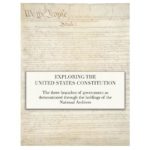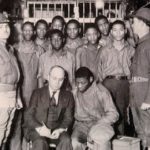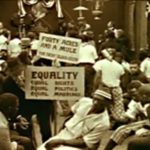Each chapter connects one or more of the billions of primary source documents in the holdings of the National Archives to the principles found in the United States Constitution. These documents exemplify the workings of the three branches of the federal government as laid out in our Constitution. This eBook is available as a Multi-Touch book for iPad and Mac on iTunes, or for PC, Android devices, Mac, iPhone, iPad, or eReader with Scribd.
14th Amendment: Battles for Equality
The 14th Amendment wrote the Declaration of Independence’s promise of freedom and equality into the Constitution. It transformed the Constitution forever. And it’s at the heart of what many scholars refer to as America’s “Second Founding.” Even so, the 14th Amendment is the focus of many of the most important constitutional debates (and Supreme Court cases) today. In many ways, the history of the modern Supreme Court is really a history of modern-day battles over the 14th Amendment’s meaning. Nearly every constitutional case that you care about today turns on the 14th Amendment.
The Amendment Process: Ratifying the 19th Amendment
In this activity, students will analyze historical records of Congress and the U.S. government to understand the sequence of steps in the amendment process. Students will study each document and match it to the step in the process that it illustrates.
When put in proper sequence, the documents will show the process by which the 19th Amendment – prohibiting the federal government or states from denying the right to vote on the basis of sex – was added to the Constitution.
Then students will reflect on the process, and the roles that the people, president, Congress and the states play.
Twelve Angry Men: Trial by Jury as a Right and as a Political Institution
Twelve Angry Men, originally written for television by Reginald Rose in 1954 and subsequently adapted for stage (1955), film(1957) and television again (1997), effectively conveys the central importance of the right to a jury trial afforded by Article III of the Constitution as well as Amendments V, VI, and XIV.
To Kill A Mockingbird and the Scottsboro Boys Trial: Profiles in Courage
Scottsboro Boys and To Kill a Mockingbird: Two Trials for the Classroom

In this lesson, students will perform a comparative close reading of select informational texts from the Scottsboro Boys trials alongside sections from To Kill a Mockingbird. Students analyze the two trials and the characters and arguments involved in them to see how fictional “truth” both mirrors and departs from the factual experience that inspired it.
Birth of a Nation, the NAACP, and the Balancing of Rights
Women and the Right to Vote
Did the Nineteenth Amendment provide women with more than the right to vote? Which amendment process was used? How did this amendment affect the United States in the last one hundred years? All these questions and many others are discussed in this lesson.
A Conversation on the 14th Amendment with Justice Ginsburg
Civic Action and Change (Lesson Plan and Powerpoint)
Students explore examples of civic action and change by looking at the efforts in four movements in the 20th century; women’s rights, disability awareness, Native American rights, and migrant worker rights. Through these examples, student will describe the process of civic action through the I AM chart (Inform, Act, Maintain).



